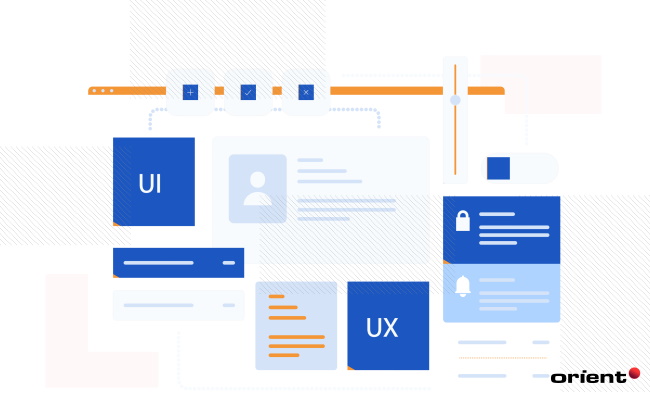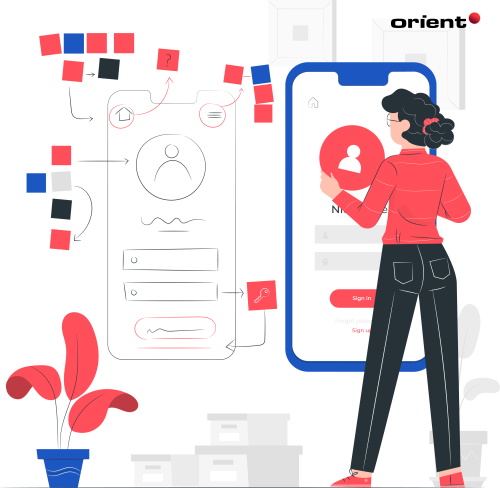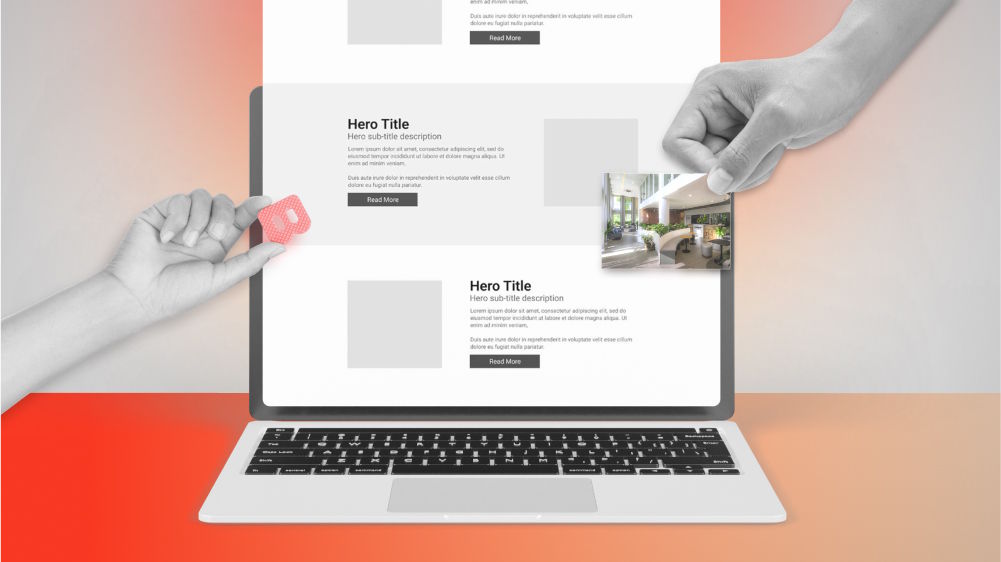UI/UX Best Practices for Designing Amazing Web Apps

Content Map
More chaptersHave you ever installed an application or run into a website with a complicated layout and lengthy content? Then, you end up on the support forum to find the instructions and eventually remove the app or abandon the website after wasting too much time. We’ll tell you that you are not alone since 38% of users tend to stop engaging with a web/app if the content and page layout are not user-friendly and attractive. What does it mean anyway? Bad UI/UX design with too many unnecessary elements almost always results in a bad user experience, and unfortunately, about a third-quarters of visitors are less likely to return to a website or an application because of that. Overall, the user interface and user experience have a powerful impact on the success of web application development. And how much does UX/UI influence web apps? We will have to delve right into the importance of UI/UX design to have a deep understanding.
The Importance of User Interface (UI) & User Experience (UX) Design
It is easier to understand if you imagine that UI/UX design is like the cover of a book. Readers will never get the chance to know how good the content inside is if they find the cover not interesting enough and refuse to read the book. That’s just an example.
Although the functions you offer can straightforwardly solve the users’ pain points, the poor experience and complicated UI design can block them from using your applications in the first place. According to ZCoastMedia, 75% of the judgments are made based on the aesthetics of the sites, which again emphasize the roles of UI and UX in web application development.
However, many web and app developers still underestimate the importance of UI/UX design and give it a lower priority. Maybe they will have to think all over again if they are aware of the critical reasons why UI/UX design is so important to the success of applications, websites, or digital products:
Good UI/UX Design Improves User Engagement & Satisfaction
Obviously, a website or an application that is visually attractive and effortless to navigate will make a better choice than the ones that are not. Good user-centered design can help users interact with the website or app much easier, and it lets most users accomplish their tasks faster, which results in higher user engagement and satisfaction, and vice versa.
For the case of websites, engaging UI design and a comfortable user experience will also lead to higher dwell time (time-on-page), which is beneficial for your page value. The average dwell time of a web page is 10-20 seconds, and if you can manage to keep the visitors on your site for more than 30 seconds, it means they are quite interested in what you offer.
Effective UI/UX Design Drives Better Conversion & Revenues
Better user engagement and happier users mean higher conversion rates and better revenues, don’t they? The ultimate goal every business aims at is to drive better conversion and revenues from their web apps, and UI/UX design plays an integral part in achieving that.
In the era of technology nowadays, users are easier to get distracted than ever since they have countless options of applications and web pages, so standing out from the competitors by offering better user experiences is extremely important. You cannot do it without good UI/UX design.
A study by Forrester Research indicates that an optimal UI design can boost the conversion of a website by 200%, and a good UX design can yield conversion rates by up to 400%. It does not stop there; user interface and user experience are also powerful tools for you to attract and acquire more new users for your web apps.
Build Brand Awareness & Acquire More Users
One of the undeniable benefits you can gain with an effective UI/UX design for your apps is a good impression, which is decisive in acquiring new users and retaining the return ones.
Most users care about easy usability and stunning interfaces, so products with good UI/UX design will surely win the attention of a new user and make him/her gravitate toward them. In addition, the UX design and UI design of your team will be one of the unique selling points people can only find in your product.
In other words, your style of UI/UX design is one of the key players in building your brand awareness. If you do it precisely, most users will be immediately reminded of your product when they discuss a good user interface and experience.
Want an Engaging UI/UX for Your Webs or Apps? Follow These 10 Best Practices
Both UI and UX are equally important in the creation of any website or app, so it falls to you and your team of UI/UX designers to make the product design elements and visual elements work in harmony. Perhaps, a few tips will be useful for your UI/UX design process:
Know Your Target Audience
As always, before you start building or designing a digital product, one crucial step you should never skip is to get to know the end-users - the ones who use your product.
Therefore, the first thing to do is draw a portrait of your targeted users, identify what they require from your product, their pain points, etc. Then figure out how you can help them accomplish their tasks and bring them a good experience with the optimized UI and UX design.
You can call all of those things’ user expectation’. To do that right, you should get into the mindset of real users and be objective.
Conduct Thorough User Research
Once you come up with the user needs, it is time to double-check them with real users. There are a variety of UX research methods to conduct user research, including surveys, interviews, polls, etc. Do not hesitate to ask users key questions about their opinions on your product’s UI/UX design, what they like and do not like, or whether they find it easy to use or not. No other ones can help you better than the users themselves. Take the feedback and use it as a reference in the design process.
Moreover, you and your design team can learn from the mistakes you made when creating an existing product of yours. Do not forget that you can also learn from other apps and your competitors. The more detailed you go into when conducting user research, the better design decisions you will make and the higher chance you get to go in the right direction.
Layout Matters But Keep It Simple
The layout of a website or app interface will significantly affect the user’s experience, so make sure that you put some thought into it. Use whitespace, also known as negative space, wisely to create a balance in the overall look of your product. Do not overcrowd the screens with too much text or too many images; otherwise, it will overwhelm users and discourage them from using your product.
Remember that a UI/UX designer’s task is to design an interface that is easy on the eyes as well as easy to use. Thus, the layout should be able to direct users’ attention to the right places and help them find what they are looking for effortlessly. If we overdo it, users find it confusing. One tip for an effective layout is to use a grid system. It will help you organize content better and make the overall look more pleasing to the eyes.
Leverage Available Design Patterns First Before Creating Your Own
Product design does not always mean you have to create everything. A simple yet useful piece of advice for UI and UX designers is to leverage all the existing design patterns that you can use for your product first. Of course, building whole new things will be the true meaning of creativity, but in some cases, it is better to reuse before creating.
So, remember that you should only create a new design pattern when you have a good reason. By taking advantage of the existing design patterns, you can avoid making common mistakes in UI/UX design. If you still have to create your own pattern afterward, you will surely learn from the available ones to optimize the new one. This will not only save you time and effort but also speed up the design process and secure the result.
Some common UI/UX design pattern libraries you can easily find are Material Design by Google, iOS Human Interface Guidelines, and Microsoft UX guidelines.
Prioritize Functionality Over Aesthetics
UI design and UX design correspond to each other, which means that a good user interface does not make any sense without a good user experience and vice versa. A beautiful UI may bring about an initial feeling of satisfaction to users, but if the UX is not up to the mark, they will quickly get frustrated and lost in using your product. Therefore, as a UI/UX designer, you should always balance UX and UI elements, or sometimes, you should prioritize functionality over aesthetics.
Do not get too caught up in making the UI look good that you forget the ultimate goal, which is to provide users with the functions they need and solve their problems. Once the basic requirements are met, then good interfaces will be more advantageous. Remember, functionality often comes first.
Do Not Overlook Product Content
Product content, such as texts and images, is also an important aspect of UI design. They contribute a lot to the overall user experience of your product. The texts should be easy to read and understand, while the images should be relevant and help users grasp the product quickly. Do not underestimate the role of content in UI and UX design, as it can make or break the user experience.
Be Consistent in Your UI Elements
Consistency is another essential key to a good UI design and every change of a visual element matters. Once you have determined the overall look of your product, make sure that you apply the same colors, fonts, and other visual elements throughout the interface design. Do not use too many colors or fonts, as it will only serve to confuse users. Use a limited color palette and always stick to it.
In terms of fonts, choose two or three fonts at most and use them consistently throughout the design. The same goes for other UI patterns and design elements such as buttons, icons, etc.
Be consistent in using them in your product’s interface to create a cohesive look. A consistent design will also help users feel more comfortable when using your product, as they will not be bombarded with too many unfamiliar things at once. Consider building a guideline of your product’s UI design elements for future reference.
Do Not Forget User Testing
User testing is a must to ensure that the interaction design works perfectly as intended without problems before release. Like in user research, you will test your product with real users throughout the design process, starting from low-fidelity prototypes to high-fidelity ones.
Collect feedback at each stage and make changes to the UI/UX design accordingly. Only by testing with real users can you be sure that your product is user-friendly and usable. Do not make assumptions about users’ needs and preferences, as you may end up making the wrong design decisions.
Summary

Creating an effective UI/UX design is not easy as it seems. It requires hard work, dedication, and a lot of trial and error. However, by following the best practices above, you will be on your way to creating a great UI/UX design for your product. Do not forget to always put users first and test your product with real users throughout the design process. With user feedback, you will be able to improve the design continuously and create the best user experience for your product.







